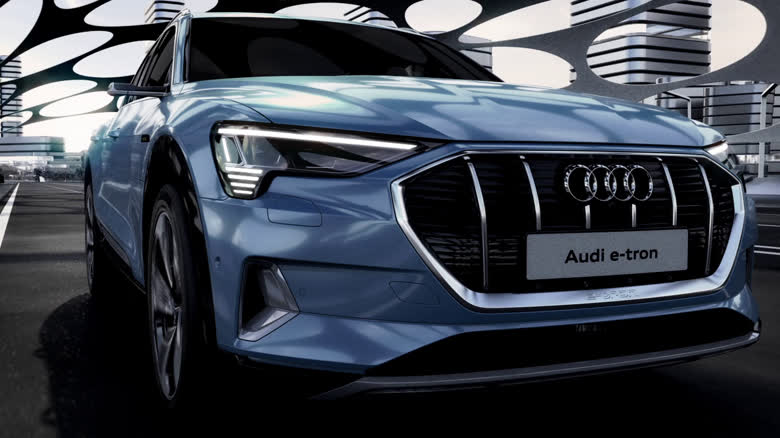Audi e-tron – Battery and Safety
The large high-voltage battery in the Audi e-tron can store up to 95 kWh of energy and is thus the foundation for the long range. There is generally no need tostop at charging stations during everyday driving. On long trips, such as when going on vacation, customers can use fast charging stations to charge with direct current (DC) at up to 150 kW –a first for series-production automobiles. This means that the Audi e-tron is all set for the next long-distance stretch of a journey in approximately half an hour. The electric SUV can also be recharged with alternating current (AC) at up to 11kW; recharging with 22kW is available as an option. Aproprietary Audi charging service provides e-tron customers with easy access to roughly 80percent of the public charging stations in Europe. Whether AC or DC, 11kW or 150kW –asingle card is all customers need to start the process. The procedure will become even more convenient with the function Plug & Charge, which will follow in 2019: The car self-authorizes at the charging station and activates it.
95 kWh of energy: the high-voltage battery system
The powerful lithium-ion battery in the Audi e-tron provides for a range of more than 400kilometers (248.5mi)in the WLTP driving cycle. The battery operates with a nominal voltage of 396 volts and stores 95kWh of energy. The battery system in the Audi e-tron is located beneath the cabin and is 2.28 meters (7.5ft)long, 1.63 meters (5.3ft)wide and 34centimeters (13.4in)high. It comprises a total of 36 cell modules in square aluminum housings, each of which is roughly the size of a shoe box. They are arranged on two levels, known as “floors” –a longer lower floor and a shorter upper one. The cell modules in the Audie-tron can reproducibly discharge and charge electricity over a broad tem perature and charge status window. They can be densely packed to achieve a very high output and energy density in the volume available. At market launch, each module is equipped with twelve pouch cells having a flexible outer skin of aluminum-coated polymer. In the future, Audi will use both technically equivalent prismatic cells in its modular concept, also in terms of a multiple supplier strategy.
An indirect cooling system distinct from the cell space ensures the high-performance operation of the battery over the long term. It is made of flat, extruded aluminum sections uniformly divided into tiny chambers. Heat is exchanged between the cells and the cooling system beneath them via a thermally conductive gel pressed beneath each cell module. In what is a particularly efficient solution, the gel evenly transfers the waste heat to the coolant via the battery housing.
The battery and all key parameters, such as charge status, power output and thermal management, are managed by the external battery management controller (BMC). This is located in the occupant cell on the right A-pillar of the Audi e-tron. The BMC communicates with both the controllers of the electric motors and the cell module controllers (CMC), each of which monitors the currents, voltage and temperature of the modules. The battery junction box (BJB), into which the high-voltage relays and fuses are integrated, is the electrical interface to the vehicle. Enclosed in a die-cast aluminum housing, it is located in the front section of the battery system. Data exchange between the BMC, the CMCs and the BJB is via a separate bus system.
Safety and rigidity: high-voltage battery and body as a composite unit
Sophisticated measures have been taken to protect the high-voltage battery of the Audie-tron. A strong enclosing frame of cast aluminum nodes and extruded sections, plusan aluminum plate 3.5millimeters (0.1in)thick protect against damage from stone impacts or curbs. Inside, a framework-like aluminum structure reinforces the battery system. Also omprised of extruded sections, it holds the cell modules like a typecase.
Including the housing with its sophisticated crash structures comprising 47 percent extruded aluminum sections, 36 percent aluminum sheet and 17 percent die cast aluminum parts,the battery system weighs around 700 kilograms(1,543.2lb). It is bolted to the body structure of the Audi e-tron at 35 points. This increases its torsional rigidity by 27 percent and contributes to the high level of the safety of the Audie-tron, as does the cooling system bonded to the outside of the battery housing. Compared to a conventional SUV, the Audi e-tron offers 45 percent higher torsional rigidity, a key parameter for precise handling and acoustic comfort.
Status 11/201

